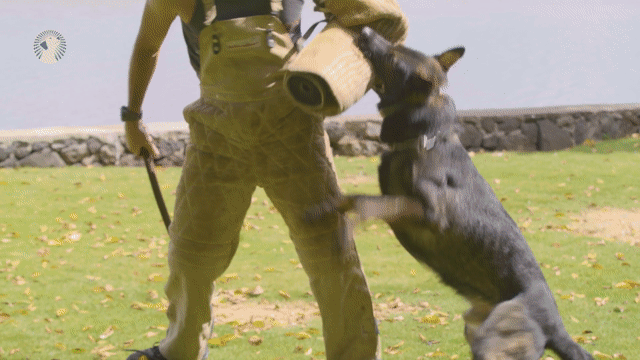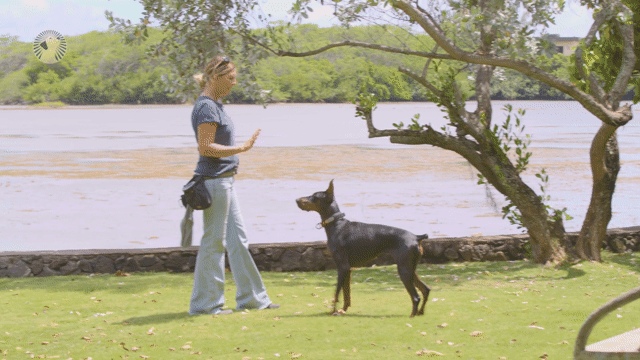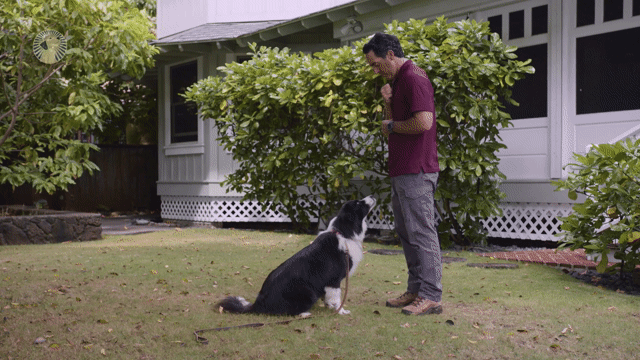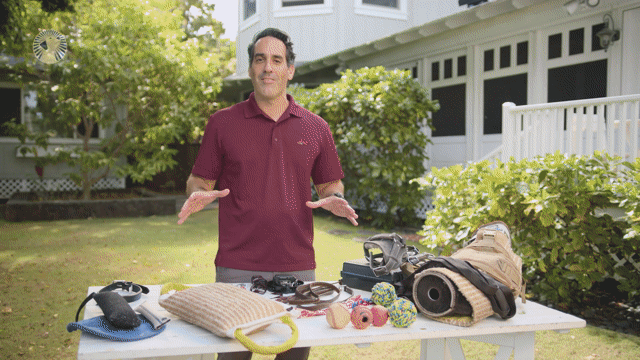Why Do People Use a Stick to Tap on a Dog While Bite Training?
To understand the use of the stick, one must first understand the different schools of thought on the matter and how the dog views the helper (the one wearing the protective bite gear).
There are typically two situations the stick is used in this manner:
- During service dog training; and
- During bite training for a sport
You can learn to spot the difference between training for sport & training for law enforcement service by observing who wields the stick during the training session.
- If the helper (or both helper & handler) holds the stick, it is likely service dog training.
- If only the handler holds the stick, it is likely sport dog training.
Sport Dog Bite Training
The handler uses sticks to hit the dogs out of the need for correction to not bite. This often occurs during bark and hold exercises, which entail the dog barking and holding the helper in place. If the dog bites while the helper is standing still, the handler smacks the dog with the stick as a correction to let the dog know that it should not bite when the helper is standing still.
The dog is taught to think of the helper as prey during sports training and therefore thinks of the bark and hold exercises as a baiting game. If the dog barks enough, the helper will run, and the dog gives chase and bites the prey.
Service Dog Bite Training
In contrast, the helper uses sticks to hit the dogs, stressing them and testing their nerves. During service dog training, the dog is not taught to see the helper as prey. Instead, the dog sees the helper as a fighting partner. A fighting partner would need to be taken very seriously by the dog during real-life scenarios. Therefore, the dog does not view the bark and hold exercise as a baiting game.
The fighting partner has an object that can cause the dog pain. Therefore, the dog will not sit near the helper as they often do in sports training. The dog would stand further back away from the danger and alert the handler they have located the danger.
The Debate Between Sport & Service Trainers
There is an ongoing debate between the two types of trainers. Sports trainers see the helper using the stick and view it as bad because they believe it signifies the dog being corrected by their prey, which should never happen. However, they believe this because they have a different perspective on how the dog views the helper.
If the dog is trained to view the helper as prey, they would be correct. But, because service dogs view the helpers as adversaries, the stick becomes a good thing because it signifies the danger posed by a suspect in a real-life scenario.
So, Which is Better?
It depends on what you are looking for in a dog. If you want a dog that will be calm and collected under threats of harm, you will want to train your dog with a service dog mentality. However, if you want a dog that will be aggressive and have a high prey drive, you will want to train your dog with a sports mentality.
It is important to understand that both methods have their pros and cons. It is up to the handler to decide which method is best for their situation.
Is Bite Training Abusive?
Many people dislike the idea of dogs being hit during these exercises. But, it is important to understand that it is especially important for service dogs to maintain their composure during these exercises because they will be working in high-stress, highly dangerous environments. They can't let the fear of being smacked cloud their judgment.
Bite training for a sport is a different story. The dogs in these cases are not working and therefore don't have the same level of stress. However, the dogs are still being hit out of correction of an error, not because the trainer enjoys it. And, if the dog is outside of the sports arena and using this skill in a real-life scenario, there is still an element of danger in chasing prey. So, for the handler to have a firm command of the dog is a matter of safety.
Ultimately, the use of the stick is not abusive if used correctly. It is simply a training tool to correct a dog's behavior. It is no different than using a prong collar to correct a dog's pulling behavior when used correctly. Both are simply tools to help the dog learn what is expected of them.
Sport & Protection Dog Training
Whether you choose to train your dog for sport or protection, The Beacon Dog Academy can help you get started on the right foot. With our video training courses, you will have everything you need to get started.
The first step in training a sport or protection dog is to build a bond between the trainer and the dog. With our course, you will learn how to build a bond with your dog and train them using positive reinforcement. You will also learn how important it is to understand your dog's body language and how to read their cues.
After completing the course, you will be ready to start training your dog for either sport or protection. You will have the skills and knowledge you need to give your dog the best chance at success. So, check out this FREE introductory video & sign up for the course today!
Useful Ressources

Sport and Personal Protection Dogs
Dog training is not always easy, however, Daniel's methods are amazing and he makes it seem simple. The techniques work wonders on both you and your dog! What high level precision training looks like in certain breeds made for Sport and Protection training.

Movie Dogs
Training with simple techniques can be a success and leads to happiness for both pet parents and their four-legged friends! A glimpse into the training and performance of Movie and Tv/studio dogs.

Focus and Attention
The Beacon Dog Academy is a fun, interactive experience for dogs and their owners that will help you build laser-sharp attention skills in any environment.

Key Training Tools and Gear
As a dog trainer, you need the right tools to make training your dog easier. Learn how to choose the best dog training tools and gear for training sessions.

A Quick Guide to Protection Dog Sports
Sports for protection dogs can be grueling for both the dog and the handler. They require not only athleticism but also mental and emotional toughness. Few other activities demand such complete dedication and willingness to push past self-imposed limits than the protection dog sports.

The Best Dog Breeds for Protection Sports
If you are involved in protection sports, such as Schutzhund, French Ring, or Belgian Ring you need a dog who is made for it. Not every dog can do well in these types of sports, so it is important to know if a dog has the necessary traits to do well in these sports.

Comprehensive Guide to Sporting Dogs
If you're a sports lover, the perfect pooch companion for you may be a breed that is bred for sports. Sporting dogs are bred to be energetic, so they'll keep up with whatever routine you set for them.